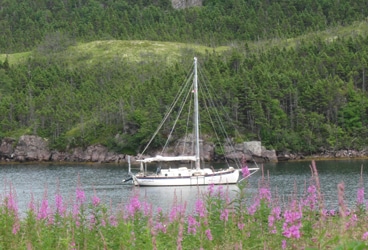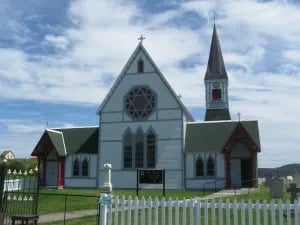
Zartman- pretty Ganymede
The north coast of Newfoundland is indented by three or four deep bays, each full of islands, fjords, tickles and coves to explore. A close look at the charts and the calendar revealed that we would not have time to gunkhole the entire coast; if we barely skimmed the surface, jumping across the entrance to each big bay and seeing only harbors at the end of each cape, we would still barely make it to where we could begin heading back south before fall advanced too far. We had already skipped all of Conception Bay to get to Old Perlican, inside of Trinity Bay, and it was with many a look toward all the cruising we were sailing past that we made our way across that to the Bonavista Peninsula. We had time only for about three harbors there, so we had to be selective.
The first turned out to the one of the best decisions we’ve ever made: Traytown Harbor, on Ireland’s Eye Island. We’ve been to hundreds of harbors in our cruising lives, but this was hands-down the prettiest place we’ve ever been. Piney green hills rising abruptly from water showing dark green or turquoise or pale yellow, depending on what was immediately under; rocky crags, lonely uninhabited cottages, wildflowers, and even a majestic bald eagle. It was such a shocking contrast to the blandness of Old Perlican. Damaris summed it up best, perhaps, as we tromped through the fresh-smelling, damp forest: “Daddy,” she asked. “Are we in Narnia?” It was, indeed, like a different world than ours, with only the ruins of ancient settler’s cottages and an overgrown graveyard to remind us that we were still in our own place.

The next stop was Trinity, one of the first major fishing ports in Newfoundland. No one fishes there now, and most of the residents are summer-only, but Danielle saw a house for sale that charmed her so much she emailed the real estate agent to ask for details. There are some fine trails over grassy hills that we enjoyed walking on, and the tiny public library had the best collection of ancient children’s books I’ve seen anywhere. No throwing out books that don’t get borrowed there: they keep everything they get, and it was like the best, most cluttery used book store you’ve ever seen. They let us check out a copy of The Horse and His Boy, the only one of the Chronicles of Narnia our collection is missing. We had a marathon reading session that night and next morning, returning it the day after so we could carry on to Catalina.
There was not much of interest in Catalina (pronounced Catal-eye-nah); it was along the lines of Old Perlican, all longliners at the wharves and trucks carting fish away at all hours. The harbormaster warned us that a 300-foot ship carrying salt was to arrive at 5:30 next morning, and might need room in the basin to turn around. “She’ll run aground before she reaches where we’re anchored,” I mentioned.
“Yiss. She’ve lost it and run aground there before, and ye should’ve seen how much mud she stirred up getting off.”
Getting run aground next to or on top of by a giant freighter didn’t sound like a picnic, so we weighed anchor at dawn and sailed out the channel, clearing it just in time to watch the ship come in. How he jockeyed his way into the buoyed channel that had seemed skinny to us on Ganymede, without a tug or bow thrusters is beyond me. But we were glad to not be anywhere near the turning basin with that behemoth lumbering about in there.
It was a short run around Cape Bonavista, to Bonavista Harbor inside of Bonavista Bay. John Cabot made his first landing here back in 1497, so there’s some interesting historical markers. More interesting to us, though, was the floating public pier, which made a nice change from the usual wharf so tall we couldn’t reach the edge of it from deck at low tide. Even better were the laundry machines and showers in the harbor office. There was bad weather coming, and we were glad we’d come in early, as all the latecoming refugees had to raft up to others or tie up in faraway crannies.
It wasn’t the first time I’ve walked to the grocery store in foulies, and it was worth it, since we hadn’t seen decent supplies since leaving St John’s. We took on water as well, though reluctantly since it had a yellowish cast and a musty taste. Still, our water from Sydney wouldn’t last forever, and the water at the commercial wharves commonly comes through hoses far too big to easily fill our bottles with. “And,” Danielle pointed out. “We can’t really know what nasty, fishy, bilge insides those big hoses get stuck into.” The Bonavista hose was a standard garden size, and we were told by a local that all the water in Newfoundland is no different. “Some’s better’n others. But ye’ll find it all yellow—we mostly boils it first.” Boiling it all is not an option for us, but with lemonade or iced tea powder the taste is mostly masked, and it’s certainly not the first adventure in water we’ve endured while cruising.
In what’s beginning to show as a pattern, we were kept in harbor for a couple of days longer than we wanted—it seems the weather systems are coming through about a week apart, with every weekend featuring rain and wind, then a few clear days midweek. No matter, though. We were tied up very affordably, with showers, laundry, wifi and groceries all within easy reach. If the weather was going to be too inclement to explore secluded coves and islands anyway, there were certainly worse places to be stuck.
We are the Zartman family: Ben & Danielle, and our three girls, Antigone, Emily and Damaris. We created this blog to chronicle our sailing adventures on Ganymede, a home-finished 31-foot gaff-rigged cutter, which has been our home since 2009, when we sailed from San Francisco, California, to the Sea of Cortez, then down along the Central American coast. Currently in Newport, Rhode Island, we plan to sail to Canada, the U.K., and beyond this summer.








